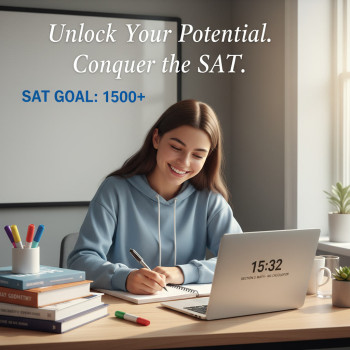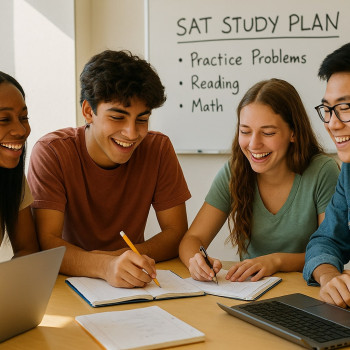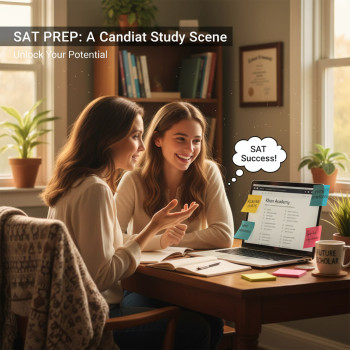Why study groups aren’t just a trend — they’re a strategy
When you think of SAT prep, you might picture solitary nights with a stack of practice tests and a ticking clock. But something different happens when students bring their books, laptops, and snacks into a room together: the test becomes less like a solitary battle and more like a team project. Study groups are not about socializing at the expense of studying; done well, they multiply learning, build accountability, and expose you to approaches you’d never try alone.
What study groups actually do for SAT preparation
At their best, study groups do three key things: they broaden perspective, increase practice opportunities, and reduce anxiety. One classmate explains a faster way to approach data interpretation on the Math section. Another models an effective passage-mapping strategy for Evidence-Based Reading and Writing (EBRW). Together you replay, discuss, and iterate — learning that sticks.
Real talk: the advantages and the pitfalls
Let’s be honest. Study groups can be amazing, but they can also be time sinks. It depends on how you organize them. Below is a realistic look at what works and what doesn’t.
Pros
- Peer explanation: Teaching a concept to a friend is one of the fastest ways to learn it yourself.
- Accountability: Regular meetings make you less likely to procrastinate on practice tests.
- Variety of strategies: You’ll see multiple ways to tackle problem types — especially helpful for tricky Reading questions and multi-step Math problems.
- Motivation and morale: Test prep can feel isolating. A group keeps the energy up.
- Targeted practice: Groups can split up topics (Grammar rules, heart of the passage, coordinate geometry), making sessions efficient.
Cons — and how to avoid them
- Off-topic chatter: Set a clear agenda and time limits to keep focus.
- Uneven participation: Rotate roles so stronger students don’t do all the explaining and weaker students aren’t passive.
- Surface-level review: Avoid “we skimmed practice tests” by assigning focused, accountable tasks.
- Groupthink: Encourage members to explain multiple strategies, not just the majority approach.
How to build an effective SAT study group
There’s an art to forming a group that actually helps scores. Here’s a student-tested blueprint, from picking people to designing sessions.
Who to invite
Choose 3–6 classmates who are committed. Too few and you miss perspective; too many and it becomes chaotic. Look for a mix of strengths: someone who loves grammar, a student who consistently scores well on Math, a peer patient at explaining reading strategies, and a timekeeper who keeps meetings on rail.
Set expectations up front
- Meeting cadence: Decide whether you’ll meet twice a week, weekly, or more frequently in the final stretch.
- Time commitment: Agree on session length (90 minutes is a sweet spot).
- Pre-work: Assign tasks so everyone comes prepared (e.g., complete 25 practice problems, annotate one reading passage).
- Goals: Define measurable goals—improve practice-test score by X points, master the major grammar rules, or reduce careless Math errors by Y%.
Roles that keep sessions productive
Rotate these roles every meeting so everyone practices leadership and accountability:
- Facilitator — Keeps the agenda, starts/stops activities, and ensures everyone participates.
- Problem curator — Chooses practice questions or passages and has solutions/explanations ready.
- Timekeeper — Tracks time and enforces limits for each segment.
- Clarifier — Paraphrases explanations to check understanding and asks follow-up questions.
- Accountability tracker — Notes who completed pre-work and records progress metrics.
What a productive session looks like (sample agenda)
Below is a sample 90-minute session that balances practice, explanation, and review. This structure prevents sessions from dissolving into aimless discussion.
| Segment | Time | Activity | Purpose |
|---|---|---|---|
| Warm-up | 10 minutes | Short, timed drill (5–8 mixed questions) | Raise focus; identify immediate trouble spots |
| Deep dive | 30 minutes | Work through a set topic (e.g., algebraic functions or passage structure) | Build conceptual understanding and compare approaches |
| Practice round | 25 minutes | Timed practice (one reading passage or a set of Math questions) | Simulate test conditions and practice pacing |
| Review | 20 minutes | Explain solutions, focus on errors, and note strategy takeaways | Consolidate learning and assign follow-up work |
| Wrap-up | 5 minutes | Set pre-work and confirm next meeting | Ensure accountability |
How study groups handle each SAT section
Strategies differ by section. Here’s how groups can tackle Evidence-Based Reading and Writing and Math effectively.
Evidence-Based Reading and Writing (EBRW)
Reading and Writing are ideal for group work because explanation deepens comprehension. A few approaches that work especially well:
- Passage mapping: One student times the group as everyone silently reads and annotates; another summarizes the passage in two sentences. Compare notes to notice what each person prioritized.
- Argument tagging: For the passages that test author’s tone and purpose, tag words or sentences that reveal the author’s stance — group disagreement is informative.
- Grammar relay: For the Writing section, isolate common grammar errors (subject-verb agreement, pronoun clarity, parallelism). Have members compete to explain rules and correct sentences.
Math
Math benefits from group problem-solving because it’s visible — you can watch someone’s approach and critique steps. Use these tactics:
- Strategy swap: Take the same problem and have members solve it three different ways (algebraic manipulation, diagram, number testing). Compare efficiency and reliability.
- Concept clinics: If coordinate geometry or functions are a weak spot, pick one concept per week and build a short mini-lesson inside the group.
- Error analysis: Collect the group’s wrong answers from practice and turn them into mini-lessons, focusing on the type of mistake (careless vs. conceptual).
Measuring success — how to track progress as a group
Without measurement, it’s easy to feel busy but make little progress. Use both quantitative and qualitative measures.
Quantitative measures
- Practice test scores: Record full-length scores and section-level scores. Aim for steady, realistic improvement.
- Timing accuracy: Track how many questions you finish within the allotted time for each section.
- Error-type counts: Log whether mistakes are calculation errors, misunderstanding the question, or silly slips.
Qualitative measures
- Confidence levels: At the end of each week, rate confidence in major topic areas (1–5 scale).
- Strategy adoption: Note which strategies each member uses independently after group sessions.
- Stress levels: Talk about test anxiety and coping techniques — reduced stress is progress too.
A six-week sample plan for groups (example)
Here’s a compact plan for students starting roughly six weeks before test day. It balances group sessions with independent work and simulates realistic pacing.
| Week | Group focus | Individual work | Milestone |
|---|---|---|---|
| Week 1 | Baseline — take a timed practice test together, review results | Analyze weak sections; complete targeted practice sets | Establish baseline score and top 3 target areas |
| Week 2 | Foundations — algebra and grammar clinics | Daily 30–45 minute practice on weak topics | Reduce careless errors in targeted areas |
| Week 3 | Strategy — reading passage mapping and advanced problem solving | One full-length timed practice test over the weekend | Improve pacing and stamina |
| Week 4 | Error analysis — convert mistakes into mini-lessons | Drill weak question types (20–30 Q/day) | Start seeing score improvements on practice sections |
| Week 5 | Simulation — a timed section-by-section run-through, with group reflections | Fine-tune target strategies, practice pacing | Consistent section scores |
| Week 6 | Polish and mindset — light review, test-day routines, and stress-management | Short, focused practice and rest before test | Peak readiness and lowered anxiety |
How to blend peer study with individualized help
Study groups are powerful, but sometimes you hit a ceiling where a concept needs targeted instruction. That’s where combining group work with one-on-one help makes a major difference. For example, if everyone in the group struggles with the same math subtopic, a short session with a specialist can translate confusion into clarity faster than repeatedly stumbling through it together.
Some students find that supplementing group meetings with personalized tutoring sparks the most growth. Tutors can provide tailored study plans, diagnose persistent errors, and offer alternative explanations that click for an individual learner. If you’re using services like Sparkl’s personalized tutoring, you can keep the collaborative benefits of the group while plugging holes with expert 1-on-1 guidance and AI-driven insights — then bring those insights back to the group to raise everyone’s game.
Making meetings inclusive and useful for everyone
Groups form naturally between friends, but they’re most effective when they’re inclusive, structured, and respectful of different learning styles. Here’s how to make sessions beneficial for all members.
Normalize mistakes and curiosity
Create an environment where questions are welcome and admitting confusion is treated as a step toward mastery, not a weakness. Celebrate puzzles solved and share the thought process behind them.
Be mindful of learning styles
Some students learn by listening, others by doing. Alternate between discussion, hands-on practice, and short mini-lectures so everyone can engage in a way that suits them.
Use tech wisely
Take advantage of shared digital tools to keep resources organized: a shared spaced-repetition list for vocabulary, a document of solved problems, and timing apps for realistic practice. But don’t let tech distract — the human interpretation of errors is the point.
Conflict, accountability, and what to do when momentum stalls
All groups hit rough patches. People get busy, motivation dips, and attendance drops. Tackle these issues head-on with transparency.
Recalibrate expectations
If attendance wanes, ask whether the meeting time or format is the problem. Reassess the agenda and rotate responsibilities to keep members invested.
Handle chronic non-participation
Polite, direct conversation usually fixes things. Ask the member if they’re still committed; if not, welcome replacements. Study groups thrive on reciprocity — everyone should contribute whether through problem sets, time, or organization.
Celebrate milestones
Recognize improvements — a small party after someone beats their target score or a shout-out when the group increases average practice-test scores keeps morale high.
Stories from students: how study groups actually changed scores
Here are concise examples that show the group effect in action.
- Maria, a junior, improved her Math score by 80 points after her group ran focused algebra clinics. Seeing three classmates solve the same quadratic problem in different ways helped her find a faster approach that fit her thinking.
- Jason, who struggled with passage pacing, joined a group that timed one passage per meeting and discussed summarization techniques. Over three weeks his reading speed and comprehension increased, and his sectional score rose by 60 points.
- A mixed-ability group used Sparkl’s AI-driven insights to identify a common grammar trap. They then scheduled brief 1-on-1 sessions with a tutor to master the rule. The combined approach accelerated improvement for everyone.
Practical checklist before every study group meeting
- Agenda posted 24 hours in advance.
- Assigned pre-work completed by everyone.
- Roles rotated and ready (facilitator, timekeeper, curator).
- Materials gathered: practice questions, scratch paper, timers.
- One takeaway goal defined (e.g., reduce Diagram questions errors).
Final thoughts: make the group your secret weapon
Study groups transform SAT prep from a lonely marathon into a collaborative workshop. They expose you to new strategies, keep you honest about practice, and help with the emotional side of test prep. When you combine the momentum of a group with targeted tools like 1-on-1 tutoring or AI-driven insights, you get a hybrid that matches the power of collaboration with the precision of personalized guidance.
So gather a few committed classmates, set a clear agenda, and start with one focused goal. The group won’t just build your knowledge — it will build confidence. And in a two-day sprint like the SAT, confidence often shows up as calmness, better time management, and, ultimately, higher scores.




















No Comments
Leave a comment Cancel